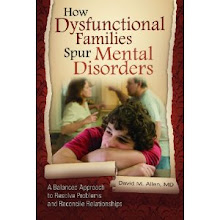Back beginning
with the March/April 2001 issue of a magazine that was originally produced for the followers of the new family systems psychotherapy models, it changed its name from the Family Therapy Networker to the Psychotherapy Network. The magazine had
started 20 years earlier in January, 1982. What happened?
The editor of
the magazine up until his recent death was a fellow by the name of Rich Simon. In the
March/April issue of the magazine in 2012 he related the fascinating history of why this happened in an essay called Still
Crazy After All These Years? A Look at 30 Years of the Networker.
Back in the 1980’s
and 1990’s there was an explosion of new ideas about how to get psychotherapy
patients to change both their behaviors and their negative moods that went well beyond
the three basic paradigms or schools of therapy at the time: psychodynamic,
cognitive-behavioral, and emotion-focused. Something like 300 different schools
came to be, although most of them were just variations on the existing schools.
The Milton Erickson Foundation in
Phoenix, AZ sponsored several “Evolution of Psychotherapy” Conferences in which
the leaders of the various schools came to argue with each other in front of
large audiences.
Family Systems
therapy was the most noteworthy of the new models, because it was seemingly the
first to recognize that since human beings are among the most social of all
organisms, perhaps looking at herd behavior might tell us more about human
beings than just looking at them in isolation.
Of course, even
within systems therapy, there were quite a few widely varying ideas about how
to proceed with psychotherapy clients. In the beginning, the Networker profiled the colorful
characters who were coming up with them: Salvador Minuchen, Jay Haley, Murray
Bowen, Mara Selvini-Palazzoli, Virginia Satir, Ivan Boszormenyi-Nagy, and Carl Whitaker.
Of course, just like in all of the earlier schools, there was also plenty of nonsense within the movement. Some theorists imagined a sort of Zen perspective in which the thought that we had individual selves to call our own was an illusion. They became like extreme behaviorists, who instead of viewing humans as rats in a physical maze, viewed them as rats in a family homeostatic maze - with no ability to think for themselves.
Others started explaining real brain diseases
like schizophrenia on the basis of family double binds, which themselves were
very common in the families of people without any schizophrenic members. Still
others viewed the dynamics of any particular family as if they had just come
into being as is, without reference to the cultural milieu in which they
developed. Even Murray Bowen, who developed a three-generational model, only
looked at who was enmeshed or at odds with whom, without specifying over what
behaviors they were enmeshed or at odds about.
According to Simon, feminists started complaining that women seemed to be getting the brunt of the blame for, as well as the responsibility for changing, the family dynamics - especially when patients with histories of child abuse became brave enough to come forward. The latter issue also led to a reaction in which people were accused of having “false memories” (and which were being prompted by some therapists if the people were suggestible enough). Some elements of society were also upset with the so-called “abuse excuse” in which victims were seemingly encouraged to see themselves as permanently damaged victims who took no personal responsibility for themselves.
The confluence
of converging forces mentioned in the masthead of this blog then started to
develop with a fury. Longer-term treatments were no longer being covered by insurance,
which only covered symptomatic treatment. Bogus “medical necessity” criteria
were used to drastically cut down the number of sessions therapists could
administer. Drugs were pushed even for diagnoses for which there was no good
evidence that they worked at all. “Major Depression” became just ‘’depression.”
“Biological”
psychiatrists who were not even aware of the latest discoveries in neuroscience
pushed a disease model for everything. In fact, science has clearly showed beyond a reasonable
doubt that the structure of the “plastic” human brain is in part determined by
interpersonal interactions, and that most of what we do is learned and done automatically
in response to environmental clues without any conscious deliberations.
Simon added that
they did take a lot of flack after the magazine got renamed for “abandoning”
systems therapy, but, “…as we saw it, we were just creating room for a bigger,
more diverse “blended” family of therapeutic approaches.”








No comments:
Post a Comment